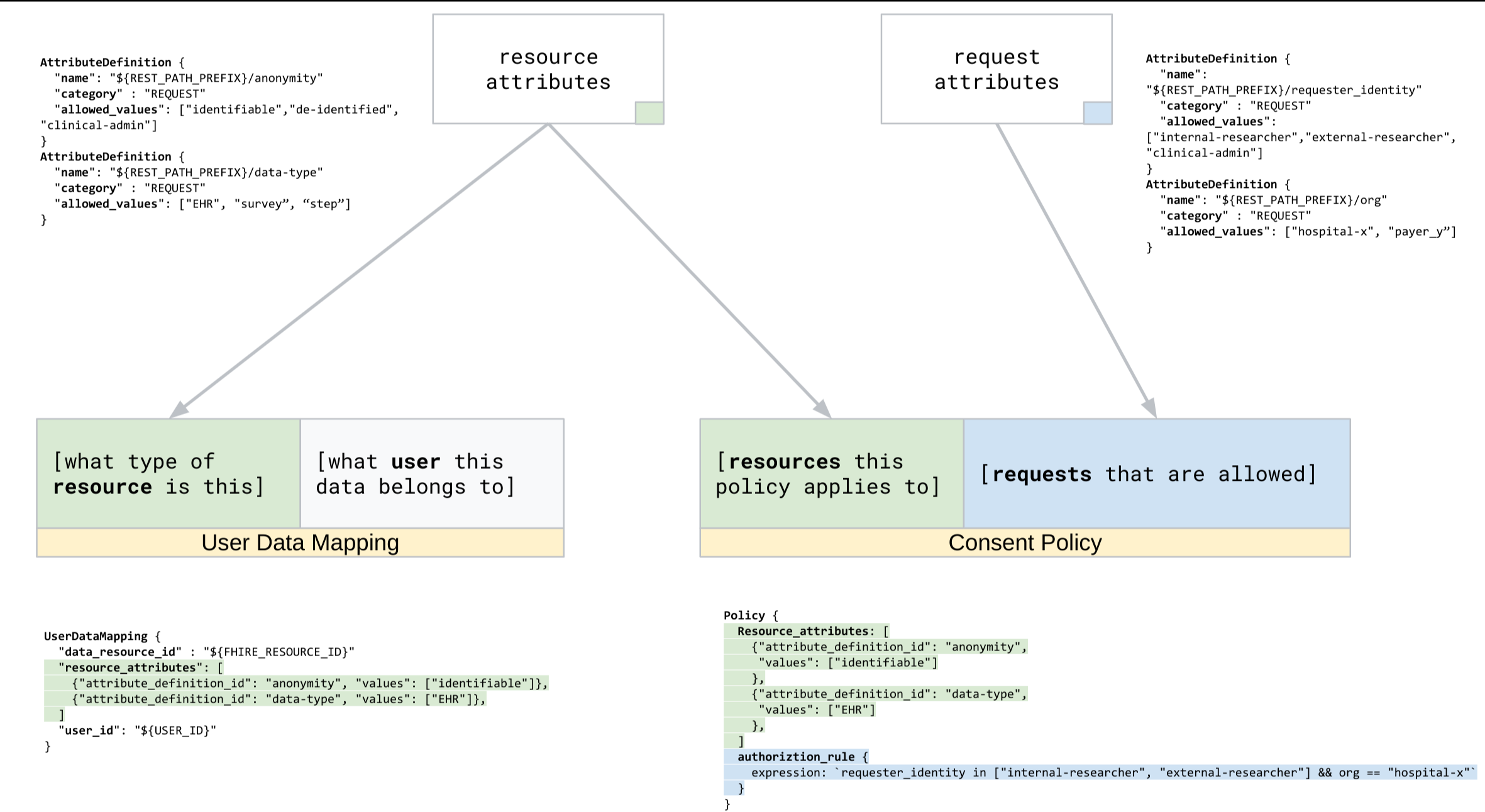This page describes how to register user data with the Consent Management API.
Data elements are registered with the Consent Management API and connected to consents using user data mappings. User data is never stored in the Consent Management API.
The user data mappings, represented as UserDataMappings
resources, include the following elements:
- A user ID that identifies the user. This ID matches the ID the application provided the Consent Management API when registering the consent.
- A data ID that identifies user data stored elsewhere, such as on Google Cloud or on-premises. The data ID can be an opaque ID, a URL, or any other identifier.
- Resource attributes, which describe the characteristics of the user data using
resource attribute values configured for the consent store using attribute
definitions. For example, the data could include the
attribute_definition_iddata_identifiablewith the value ofde-identified.
The following diagram shows the data flow for creating user data mappings:

Registering user data mappings
To create a user data mapping, use the
projects.locations.datasets.consentStores.userDataMappings.create
method. Make a POST request and specify the following information in the
request:
- The name of the parent consent store
- A unique and opaque
userIDthat represents the user with whom the data element is associated - An identifier for the user data resource, such as the REST path to a unique resource
- A set of
RESOURCEattributes that describe the data element - An access token
curl
The following sample shows a POST request using curl:
curl -X POST \
-H "Authorization: Bearer $(gcloud auth application-default print-access-token)" \
-H "Content-Type: application/consent+json; charset=utf-8" \
--data "{
'user_id': 'USER_ID',
'data_id' : 'DATA_ID',
'resource_attributes': [{
'attribute_definition_id': 'data_identifiable',
'values': ['de-identified']
}]
}" \
"https://healthcare.googleapis.com/v1/projects/PROJECT_ID/locations/LOCATION/datasets/DATASET_ID/consentStores/CONSENT_STORE_ID/userDataMappings"
If the request is successful, the server returns a response similar to the following sample in JSON format:
{
"name": "projects/PROJECT_ID/locations/LOCATION/datasets/DATASET_ID/consentStores/CONSENT_STORE_ID/userDataMappings/USER_DATA_MAPPING_ID",
"dataId": "DATA_ID",
"userId": "USER_ID",
"resourceAttributes": [
{
"attributeDefinitionId": "data_identifiable",
"values": [
"de-identified"
]
}
]
}
PowerShell
The following sample shows a POST request using Windows PowerShell:
$cred = gcloud auth application-default print-access-token
$headers = @{ Authorization = "Bearer $cred" }
Invoke-WebRequest `
-Method Post `
-Headers $headers `
-ContentType: "application/consent+json; charset=utf-8" `
-Body "{
'user_id': 'USER_ID',
'data_id' : 'DATA_ID',
'resource_attributes': [{
'attribute_definition_id': 'data_identifiable',
'values': ['de-identified']
}]
}" `
-Uri "https://healthcare.googleapis.com/v1/projects/PROJECT_ID/locations/LOCATION/datasets/DATASET_ID/consentStores/CONSENT_STORE_ID/userDataMappings" | Select-Object -Expand Content
If the request is successful, the server returns a response similar to the following sample in JSON format:
{
"name": "projects/PROJECT_ID/locations/LOCATION/datasets/DATASET_ID/consentStores/CONSENT_STORE_ID/userDataMappings/USER_DATA_MAPPING_ID",
"dataId": "DATA_ID",
"userId": "USER_ID",
"resourceAttributes": [
{
"attributeDefinitionId": "data_identifiable",
"values": [
"de-identified"
]
}
]
}
Configuring data IDs
The data_id field of the user data mapping resource contains a
customer-specified string that describes the data that the user data mapping resource
refers to. Any string is permitted, such as an opaque ID or URI.
Data IDs can be as granular as is required by your application. If
the data you are registering can be described at the
table or bucket level, define data_id as the REST path to that resource.
If the data you are registering requires more granularity,
then you may want to specify specific rows or cells. If your application uses conceptual resources, such as permitted actions or classes of data, you should
define data_id with a convention that supports those use-cases.
Examples of a data_id that describes data stored in different services and at
various levels of granularity include, but are not limited to, the following:
Google Cloud Storage object
'data_id' : 'gs://BUCKET_NAME/OBJECT_NAME'
Amazon S3 object
'data_id' : 'https://BUCKET_NAME.s3.REGION.amazonaws.com/OBJECT_NAME'
BigQuery table
'data_id' : 'bigquery/v2/projects/PROJECT_ID/datasets/DATASET_ID/tables/TABLE_ID'
BigQuery row (there is no REST path for a BigQuery row, so your own identifier is necessary - one possible approach is below)
'data_id' : 'bigquery/v2/projects/PROJECT_ID/datasets/DATASET_ID/tables/TABLE_ID/myRows/ROW_ID'
BigQuery cell (there is no REST path for a BigQuery cell, so your own identifier is necessary - one possible approach is below)
'data_id' : 'bigquery/v2/projects/PROJECT_ID/datasets/DATASET_ID/tables/TABLE_ID/myRows/ROW_ID/myColumns/COLUMN_ID'
FHIR resource
'data_id' : 'https://healthcare.googleapis.com/v1/projects/PROJECT_ID/locations/LOCATION/datasets/DATASET_ID/fhirStores/FHIR_STORE_ID/fhir/Patient/PATIENT_ID'
Conceptual representation
'data_id' : 'wearables/fitness/step_count/daily_sum'
